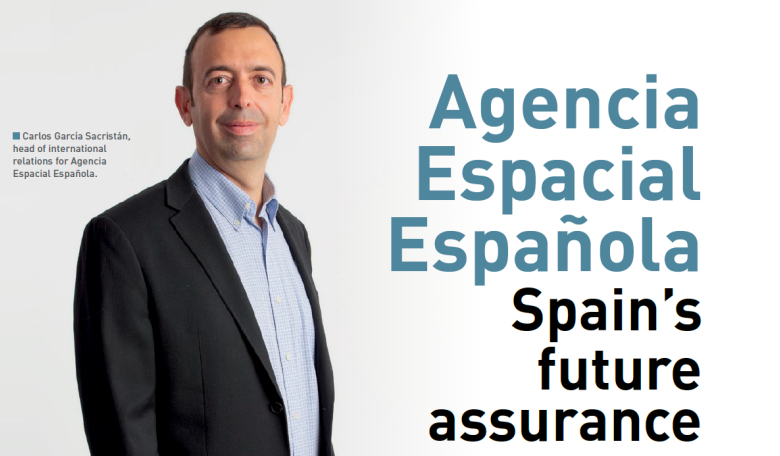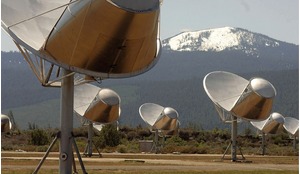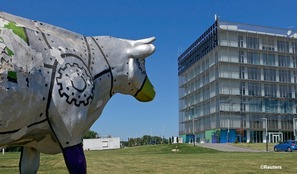As a key player in both European and international space activities for several decades, Spain has often punched above its weight, so I was pleased to meet up at the Small Satellites & Services International Forum in Malaga in February with Carlos García Sacristán, head of international relations for the recently formed Spanish Space Agency (Agencia Espacial Española).
Spain became the latest country to form its own space agency in March 2023 when the nation’s government passed Royal Decree 158/2023, which approved the bylaws of the Agencia Espacial Española (AEE). It followed in the footsteps of its European neighbour Portugal which created a space agency in 2019.
During a break on the final day of the Small Satellites & Services International Forum (SSSIF), held in Malaga’s winter sunshine in mid-February, I sat down with Carlos García-Sacristán to find out why a country with such a long space history had only recently set up its own agency and what its future plans involved.
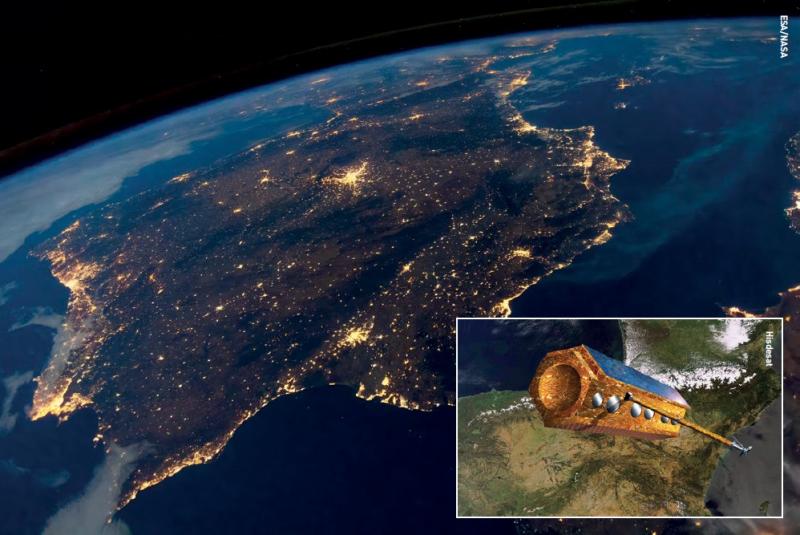 The Iberian Peninsula at night and (inset) Spain’s PAZ satellite, the country’s first high-resolution X-band synthetic aperture radar (SAR) spacecraft providing imagery for both civilian security and defence. Launched in February 2018, it operates with the twin satellites TerraSAR-X and TanDEM-X using ground stations in Madrid and in the Canary Islands.
The Iberian Peninsula at night and (inset) Spain’s PAZ satellite, the country’s first high-resolution X-band synthetic aperture radar (SAR) spacecraft providing imagery for both civilian security and defence. Launched in February 2018, it operates with the twin satellites TerraSAR-X and TanDEM-X using ground stations in Madrid and in the Canary Islands.
His role is to manage relations with national agencies as well as bilateral programmes with NASA and other space agencies and he displayed a keen enthusiasm for AEE. “The creation of the agency had been a long time coming, as several governmental bodies in Spain had for years stepped in to manage the historical role that space agencies normally play,” he said.
The creation of the agency had been a long time coming, as several governmental bodies in Spain had for years stepped in to manage the historical role that space agencies normally play
“Though the agency as an entity is really new, Spain really has had a long history of space activity. Some of its people come from the Centre for the Development of Industrial Technology (CDTI), a public entity that was developing and implementing Spanish space policy. So, although we are new, we have many ongoing programmes to manage.
“It means we already have a long-standing relationship with industry, science institutions and several government ministries, so it will be an opportunity to do additional things, as well as running all the existing projects with the European Space Agency (ESA), and at bilateral and national levels. It’s a complex challenge,” he admitted.
Spain is a founding member of ESA and has multiple bilateral partnerships with NASA, so I asked him why establish an agency now if things have been going well without one, and isn’t there a risk of just creating more bureaucratic red tape?
“Given the rapid growth and critical relevance of today’s commercial space industry and the significant role that space plays in nearly all aspects of life today, creating the AEE was absolutely necessary,” he explained.
“It will serve as a key tool for developing and growing Spain’s role in the space sector, both at home and overseas. Crucially this needs to be coupled with a long-term national space strategy that is safeguarded from any shifts in the political landscape as well as with legislation regulating the practical aspects of space-related businesses. These are tools that many countries with a space programme are working with. Spain should be no different.”
 NASA Administrator Bill Nelson meets with Spanish President Pedro Sánchez 20 May 23 as part of the signing ceremony for Spain joining the Artemis Accords.
NASA Administrator Bill Nelson meets with Spanish President Pedro Sánchez 20 May 23 as part of the signing ceremony for Spain joining the Artemis Accords.
Historically most of Spain’s investment in the space technology sector had been through ESA. This included the first flight of a Spanish astronaut, Pedro Duque, back in October 1998 on Space Shuttle Discovery (STS-95) on a nine-day flight (Mr Duque went on to become Spain’s Minister of Science from 2018 to 2021).
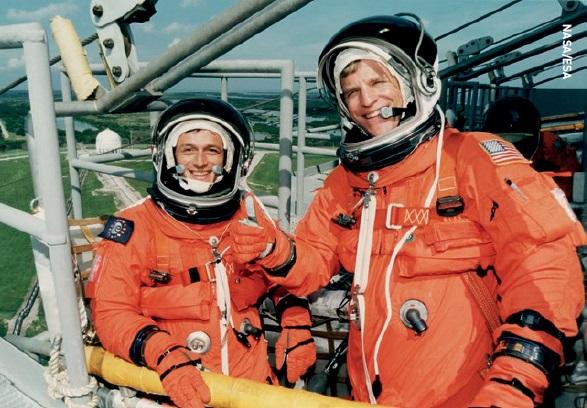 Pedro Duque (left) became the first Spanish astronaut to go into orbit on the Space Shuttle STS-95 Discovery mission in October 1998. He is pictured with colleague Scott Parazynski during their training.
Pedro Duque (left) became the first Spanish astronaut to go into orbit on the Space Shuttle STS-95 Discovery mission in October 1998. He is pictured with colleague Scott Parazynski during their training.
The country’s long-standing and successful ESA membership led some to question the value of creating its own national agency.
Bringing the agency to fruition was a complex proposition as there were many government ministries involved in space
Historically Spanish space activities have fallen under the responsibility of the CDTI, an entity with its own legal standing that belongs to the Ministry of Science and which has been the driving force behind space-related industrial development.
“We are going to maintain all this for sure,” said García Sacristán. “But it is also our aim to have more national and more bilateral programmes in which the space agency acts by itself or in collaboration with others.
“There are many programmes we are thinking of and we want to develop a national space programme with more flexibility to be able to fund according to our priorities and to make use of opportunities that arise.
“We are going to be setting up a strategic plan. We don’t have this yet but we are working on it and I would imagine that sometime between the end of this year and next year we will have something formally approved.”
Sustainability is a big issue in space today and this will be a key focus of AEE. “One of the main references to sustainable living nowadays is space traffic management and we have a space debris office to detect objects in Earth orbit (low, medium and geostationary) and provide collision avoidance services with one of the most advanced systems in the world,” he explained.
“We also plan to work on sustainability, including a mission with ESA to look at the demise of satellites to help reduce the danger due to the re-entry of satellites, and also at an international level for regulations through our participation in the UN Committee on the Peaceful Uses of Outer Space (COPUOS).”
Considering the size of Spanish space technology companies and the public budgets they receive, the country’s space industry now represents a highly significant portion of the economy, providing over a billion euro in annual turnover and employing around 5000 people.
“Of course, it is our intention to see this expand and for that the space budget will need to grow,” he said. “We need everyone, including the public and our politicians, to understand the importance of space so that we can evolve the whole ecosystem.
“Education and outreach will play a specific role, with its own office. This will ensure that we can promote the message of the importance of space to everyone outside the space community where the benefits are not always obvious or well understood.”
Astronauts are a gateway to engaging public interest in space and in November 2022 two Spaniards, the engineer Pablo Álvarez Fernández and the researcher Sara García Alonso, were introduced as new members of the ESA astronaut corps, with the former likely to be allocated a flight for from 2026 onwards.
We need everyone, including the public and our politicians, to understand the importance of space
Another keynote speaker at SSSIF, ESA’s lead optical engineer Luca Maresi, told me that Spain’s establishment of a national space agency is perceived as a positive move.
“While the specific terms governing the operations of the space agency may not be fully known yet, having a dedicated body focused on space activities is considered a positive indication of a nation’s commitment to and recognition of the importance of space exploration,” he said.
“This recognition sets the stage for discussions, debates and decisions regarding the most suitable missions for national programmes and those better suited for international cooperation. Even in cases where missions fall under national programmes, there remains an opportunity for the agency to contribute by providing technical expertise, advice and support - a role it has fulfilled in other situations over many years.
“From my perspective, I see only positive outcomes emerging from this move. It not only underscores the importance of space exploration for the nation but also facilitates strategic deliberations on the most effective allocation of resources for both national and international space initiatives.”
The creation of AEE was an important milestone, allowing Spain to join a long list of countries with an agency that plays a central role in managing, coordinating and promoting national space efforts. Given the advantages that having such a structure brings to countries, the Spanish industrial community in particular had been advocating for the establishment of a federal space agency for quite some time.
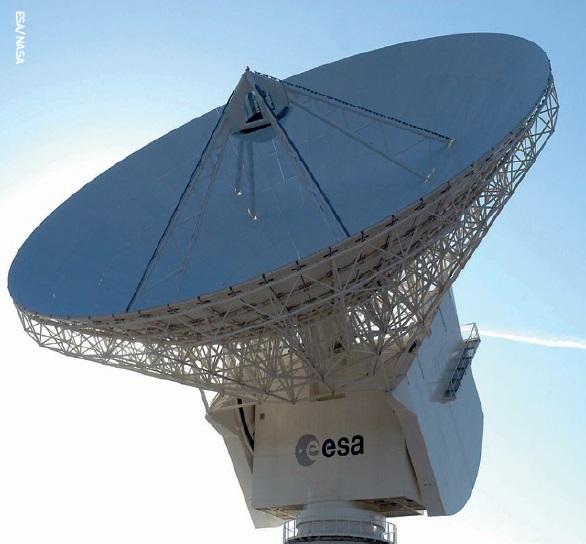 The Cebreros ground station, DSA 2 (Deep Space Antenna 2), near Madrid, Spain. It hosts a 35 m antenna with transmission and reception in X-band and reception in K-band and Ka-band. It provides routine support to deep-space missions including Mars Express, Gaia, BepiColombo, Solar Orbiter, Juice and Euclid. It will also support future ESA deep-space missions such as Hera, PLATO and Comet Interceptor.
The Cebreros ground station, DSA 2 (Deep Space Antenna 2), near Madrid, Spain. It hosts a 35 m antenna with transmission and reception in X-band and reception in K-band and Ka-band. It provides routine support to deep-space missions including Mars Express, Gaia, BepiColombo, Solar Orbiter, Juice and Euclid. It will also support future ESA deep-space missions such as Hera, PLATO and Comet Interceptor.
“Bringing the agency to fruition was a complex proposition as there were many government ministries involved in space, with most of them users of the space services and products,” explained Maresi, “so it was difficult to find the right fit for all the ministries to sometimes adapt what they were doing and to find a good way to collaborate with the agency.
“The users want to make sure that they still receive the services that they were receiving before. There have been some attempts in the past to create an agency and it was always difficult to find the right balance, and with this new entity hopefully now we have found it.”





